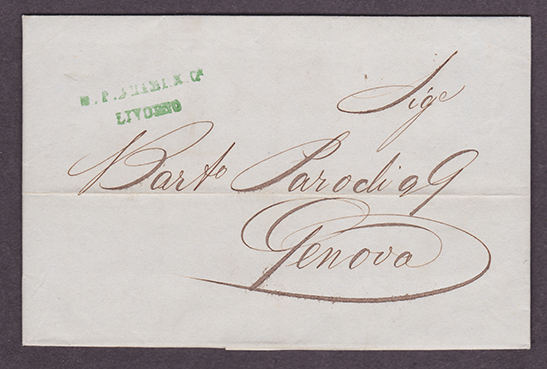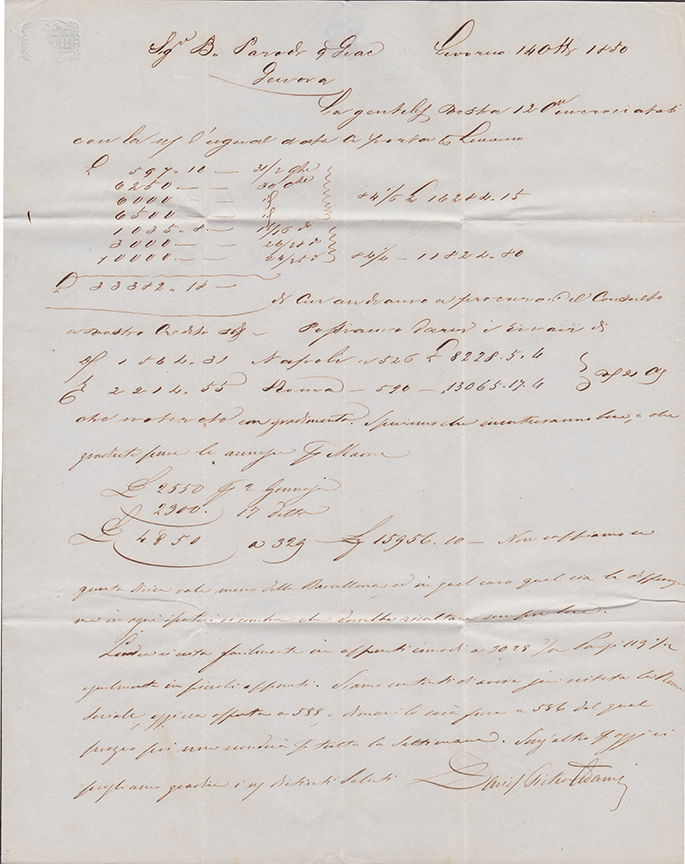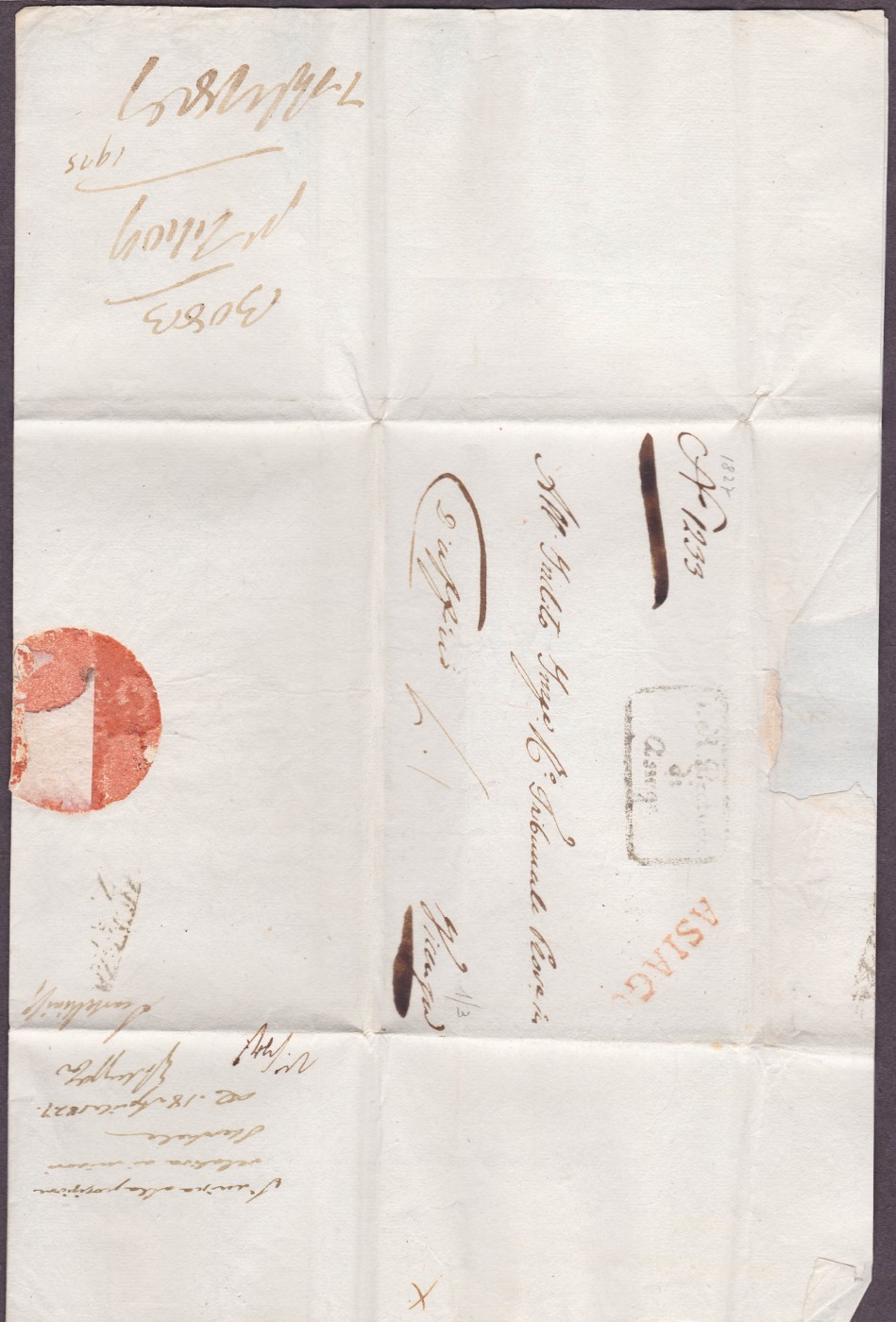|
|
Post by jamesw on Jan 16, 2017 1:43:45 GMT
Picked these two up yesterday in a lot at the estate auction. Don't know what is is about Italian stampless letters (Italian states, I guess really). I'm not Italian, and certainly don't speak the language, but they are just so pretty. Both letters were sent to the same person, Bart. Parodi (?) and look to be invoices. First one, both sides. Sent from Milan to Genoa 1840, I think. ...and contents  And the second, not quite as pretty. Sent to Genoa from Livorno in 1850  and it's contents  |
|
|
|
Post by jamesw on Mar 31, 2018 2:03:01 GMT
I was updating the images above, and thought I'd add some more stampless Italian State folded letters I've acquired since that initial post. Asiago 1827  outside spread...  contents...  |
|
|
|
Post by jamesw on Mar 31, 2018 2:10:40 GMT
Two others... Cavarzern 1830 and Udine 1840  Contents of the Cavarzern letter  Most of these appear to be letters business, invoices etc. |
|
|
|
Post by jimwentzell on Apr 5, 2018 18:44:01 GMT
I like stampless covers from that era and area as well....often they are less pricey than FRANKED (stamped) covers. Something about the cursive writing, and of course auxiliary markings.....bellisimo!!!
--Jim
|
|
rex
Member 
Posts: 1,216 
|
Post by rex on Jul 2, 2020 10:17:43 GMT
Maybe nobody cares about, but in honor of the reserch I would like to point out that Bartolomeo Parodi was one of the founders of the bank of the Kingdom of Italy 1893 , ..coming from a family of Genoese bankers with investments in south and north America.  |
|
|
|
Post by jamesw on Jul 2, 2020 11:28:22 GMT
Hello Rex! Thanks for reviving this one, and I for one DO care. I'm what's called a social postal historian, in that I like to research the people who sent and received these, not just the postal markings and routes.
Looking at the album page I created for this cover I did note that Parodi was named to the presidency of the new Geneva Discount Bank in 1845 and was first president of the Bank of Genoa. Perhaps I need to update. Thank you.
|
|
rex
Member 
Posts: 1,216 
|
Post by rex on Jul 2, 2020 12:14:11 GMT
You welcome jamesw. I would like to say that I share with you what you call Social Postal History. Good thinghs. |
|
Hugh
Member 
Posts: 740
What I collect: Worldwide Occupation Stamps and Postal History; and, anything that looks interesting.
|
Post by Hugh on Jul 11, 2024 1:40:47 GMT
Tonight I'm taking a break from French Postal Rates ... so, let me talk about a cover I got recently. I think this is probably the best place to post it.  It's official mail ... addressed from the governor of Narni to the governor of Todi. Both cities are in Umbria just under 50KM apart. At the time it was written both cities had been annexed by the Papal States. In Italian, the cover reads, 'Al molto mag. coS r. Como frello / honor. de il S r. Governatore di Todi / In Todi". As I take it, and apologies to anyone who speaks Italian, it basically means something along the lines of, 'To the very important gentleman, with friendship, the honourable governor of Todi ... in Todi". As I said, Italian is not in my skillset. Please forgive me (smile). There is no documentary evidence of it being mailed. But there is physical evidence, it was opened. As official correspondence it would have been carried to Todi by a messenger. Why? Because there was no real postal service ... It was sent in April 1510. Meet my new, oldest, cover. It has a couple of interesting features. First, there is a long paper seal ... that is still largely intact. A simple form of letterlocking was used. The wide end of the seal was glued to the back of the letter and the short, pointy end was inserted inside and attached to the letter. If the letter was opened before delivery the tip would be torn off. That's why we know it was delivered.   The second interesting feature is the seal itself. I'm not positive, but given the date, I assume it's a thin layer of softened beeswax that was pressed by a matrix - a metal stamp.  I am informed by the dealer that the research done by previous collector / owner concluded that this was the personal seal of the governor of Narni and that a transcription of the outer circle includes "BAPTISTA.SRE.OTAVACCA.JUD". Presumably the person who wrote the last couple of lines and signed the letter. The rest of the text looks like it was written by someone else ... I assume a clerk in his employ. The figure in the centre of the seal looks like a Griffin to me ... a lion with the head of an eagle (used on seals as far back as 4,000BCE). The text of the letter deals with a 'criminal' matter. Narni is holding a man who allegedly has a family in both cities. In other words, the crime is bigamy.  Cool right? A cover that is 524 years old. So, a few questions: 1 - Is this legit? I think so. The auction was done by a very reputable European dealer of old letters and documents. The previous owner is known to him as a serious and reputable collector. 2 - If it is legit ... is it a cover? We often ask about cut off dates. How about start up dates? When is a cover considered philatelic? This is one from the renaissance. To be fair, Leonhard von Taxis was the Postmaster General of the Holy Roman Empire in the 16th Century. 3 - Is it an occupation cover? When I started colleting postal history about occupations my 'start up' date was 1648 - the Treaty of Westphalia - the start of the 'modern' state system and the concept of territorial sovereignty. My thinking was that it would be a lot easier to sort out when occupations occurred if we had recognized borders. When this cover was sent, however, just about every city or region in Europe was in a constant state of flux. Essentially, everyone was being occupied by someone and a new occupation was just around the corner. Should I push back my timeline from the 17th century to the 16th? |
|
banknoteguy
Member 
Posts: 323
What I collect: 19th Century US, High denomination US (> $1), 19th century covers US, Indian Feudatory States and most recently I acquired a BigBlue [with about 5,000 stamps] and pristine pages.
|
Post by banknoteguy on Jul 11, 2024 11:28:18 GMT
I don't see any reason to doubt the authenticity of this cover. I think you are in rarefied territory. Not many people have early 16th century covers! Very cool.
Did you do the transcription of the addressing or was that in the auction lot description? I ask because I have a couple Italian states covers that I am trying to decode.
|
|
Hugh
Member 
Posts: 740
What I collect: Worldwide Occupation Stamps and Postal History; and, anything that looks interesting.
|
Post by Hugh on Jul 11, 2024 12:11:27 GMT
I don't see any reason to doubt the authenticity of this cover. I think you are in rarefied territory. Not many people have early 16th century covers! Very cool. Did you do the transcription of the addressing or was that in the auction lot description? I ask because I have a couple Italian states covers that I am trying to decode. The auction description had a transcription of the text on the cover, not a translation. I worked on that myself (hence the not-quite-literial-and-very-amateurish job I did - smile). But, the meaning is pretty clear. One thing about these very old covers ... I find the writing easier to transcribe. They took their time, they wrote larger and the handwriting is based on late medieval script. It doesn't have the all the flourishes of the various cursive penmanship styles of 18th and 19th century. Much of the time it's like printing ... each letter is clearly formed. Good luck with your covers. Post them on TSF ... maybe crowdsourcing can help. |
|
philatelia
Member  Captain Jack - my best kiloware find ever!
Captain Jack - my best kiloware find ever!
Posts: 3,654
What I collect: Ireland, Japan, Scandy, USA, Venezuela, Vatican, Bermuda, Austria
|
Post by philatelia on Jul 11, 2024 15:51:04 GMT
Hugh That cover is so freakin’ awesome! I collect the Papal States and that is absolutely super cool stampless cover from that region. The condition is superb. Ummm I’m running out of superlatives lol!
|
|
ameis33
Member  What's in a name? That which we call a rose, by any other name would smell as sweet
What's in a name? That which we call a rose, by any other name would smell as sweet
Posts: 546
What I collect: Poland and Italy Republic
|
Post by ameis33 on Jul 11, 2024 22:16:14 GMT
I’ve no doubts about the fact it’s original…
Is it a cover? Yes, but not in the way we think a cover today. There was no letter boxes, no post offices, no postmen, no postmarks, no stamps, in one word, not a postal administration as we can think today…
Regardless their attractiveness and beauty, these kind of documents should be considered more as old papers rather…
The language is pretty old, much more than the other… I read a sentence, didn’t yet put much effort, sorry, but it reminds me the dialog of the three witches of the Macbeth
Fair is foul and foul is fair:
Hover through the fog and filthy air
|
|